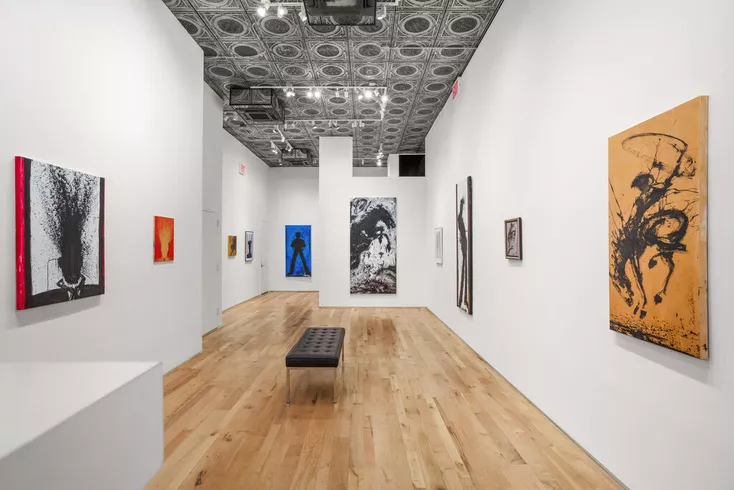Exhibitions
Richard Hambleton: Upheaval September 7 – October 5, 2024 Closed
Statement
Upheaval is an exhibition of paintings by street art pioneer Richard Hambleton, centered around a rare and seminal painting from the mid-1980s of a bucking bronco in a rodeo pit, highlighting the artist’s explorations of American mythology and Western Art.
Press Release
Hambleton’s America
by Carlo McCormick
The American myth, that story of who we are as a kind of cultural history, is a narrative best told in pictures. In some ways our neighbors often understand us better than we do, and Richard Hambleton, the nosy neighbor from Canada who was obsessed with that mega culture just to the south of him, always understood the United States with a clarity that could make us wince. In his wholly prolific career, Hambleton created a sprawling portrait of American destiny and desire unlike any other, capturing metaphorically and indelibly the face and shape of our collective fear, swagger, violence and hyperbolic grandeur.
Hambleton launched his deranged psychogeography on our shores with performative profiles of our paranoia in two seminal bodies of work- first the Mass Murder series, in which he limned the outline of our social disease, imitating the chalk outlines police create around fallen bodies. He followed that provocation with his most famous urban intervention, the Shadow Men, black figures that lurked on the peripheries of our urban environment, invading and dominating our psychological space with his loitering phantoms.
Considering the long fascination Richard Hambleton had for amplifying those effects by which the human scale can be made or felt as larger than life, it seems perhaps inevitable that he would come to excavate that heroically American genre of Western Art. A sensitive man who might count impeccable subtlety as his most effective charm, his invocation of the rugged, arrogant and uncouth cowboy always had a devious irony about it.
How it came to be that a Canadian expat living in the rundown tenements of New York’s Lower East Side came to picture a vanished West with such volatile verisimilitude is the mysterious power of a twice-told tale. I’ll always remember the time I encountered one of Hambleton’s bronco-bucking cowboys- when I asked him to contribute a painting to a show I curated called “The Wild, Wild East” in tribute to the lawless character of our neighborhood at the time- it knocked me over. I can still taste the dirt kicked up in my mouth with its distinctive flavor of horseshit. I remember that he was at the time beginning to explore the cowboy myth explicitly through the mediation of Marlboro Men ads, covering over their valiant forms with thick black paint as if they exuded from the tar in their lungs. His would similarly subvert the frontier romanticism of our counterfeit history as did Richard Prince’s Cowboy photos- contemporaneous and appropriative of Marlboro’s manly coercions- but in strikingly darker terms.
Richard used the fury and fervor of the rodeo pit to explore the machismo of American art itself. Taking for example his mid-Eighties classic “Upheaval” his tilting perspectives and ruthless cropping convene in a violent disorientation while fusing gesture with motion to revisit the basic language of Action Painting. Here, as he masterfully accents the flying forms of the tumult, he reminds us of the still recent era of Abstract Expressionists, where the splatters of flying paint might convey the ejaculate vitality of the great American male painter. As always he delivers the obvious with multilayered meanings that defy and reify our presumptions, in this case playing paean and parody to the essence of our national identity. I don’t know if the first cowboy I saw of Richard’s was among his first, but I know now that he would never settle for being a one-trick pony: he would ride that horse deep into the sunset where our dreams would meet their own horizons.

